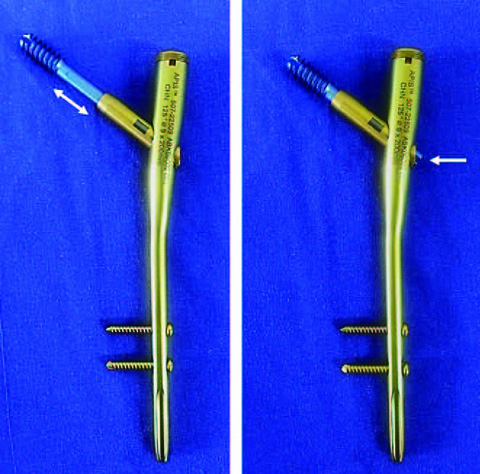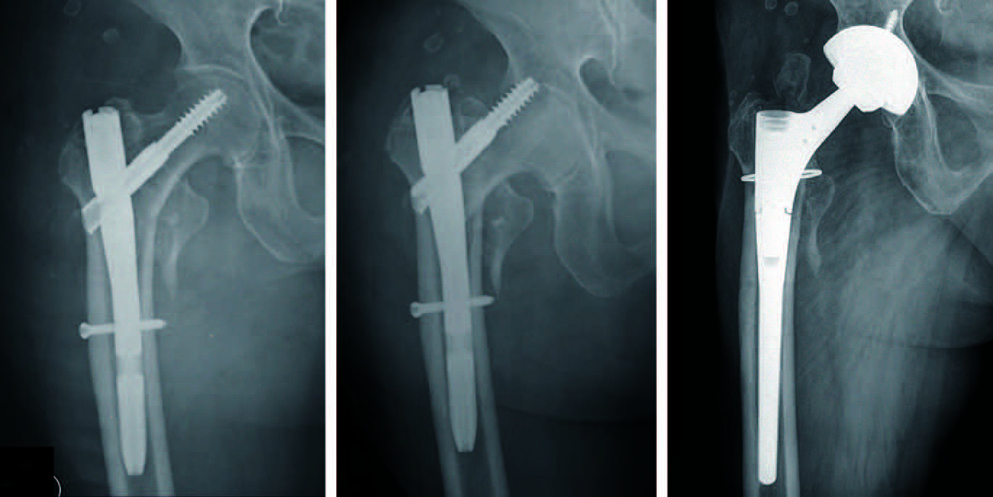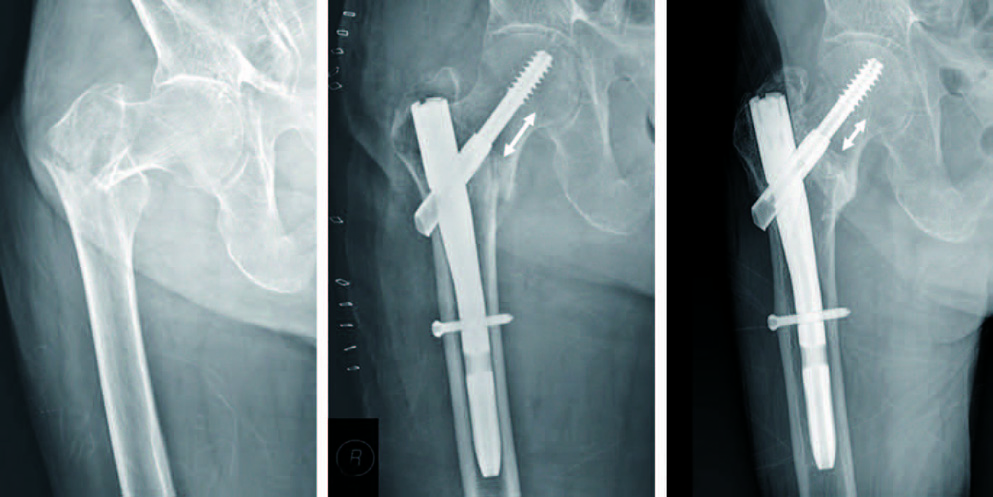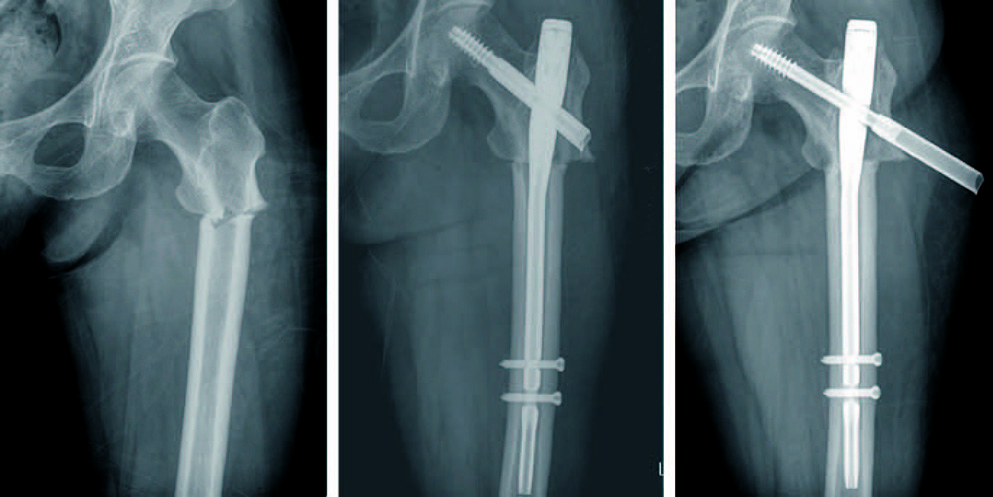Hip Pelvis.
2014 Sep;26(3):166-172. 10.5371/hp.2014.26.3.166.
Treatment of Intertrochanteric Fractures Using the Compression Hip Nail
- Affiliations
-
- 1Department of Orthopaedic Surgery, Kangwon National University College of Medicine, Chuncheon, Korea. hkyljh@kangwon.ac.kr
- KMID: 2054180
- DOI: http://doi.org/10.5371/hp.2014.26.3.166
Abstract
- PURPOSE
To investigate the clinical and radiologic outcomes following treatment of intertrochanteric fractures using the Compression Hip Nail(R) (CHN), which has a sliding lag screw.
MATERIALS AND METHODS
Twenty-eight cases of intertrochanteric fractures treated with CHN from November 2012 to October 2013 and followed-up for >6 months were included. The patient population consisted of 11 men and 17 women with a mean age of 75.2 years at the time of surgery. For the initial 11 cases, 10 mm sliding lag screws were used; the remaining 17 cases used 20 mm sliding lag screws. Clinical variables including operation time, amount of transfusion, weight-bearing start time, postoperative physical activity, and complications were investigated. The average sliding of lag screws and the average union were investigated radiologically at 3 and 6 months after surgery.
RESULTS
In an analysis of 23 cases (exclusion of 3 cases of lag screw cutout and 2 cases of nonunion), 11 (48%) recovered their pre-injury activity level. In an analysis of 25 cases (exclusion of 3 cases of cutout), 17 (68%) and 23 (92%) showed radiological union at postoperative months 3 and 6, respectively. Seven complications were noted. Cutout of the lag screw and the lateral protrusion of barrels were significantly greater in the group with 10 mm sliding lag screws as compared to the group using 20 mm sliding lag screws.
CONCLUSION
The use of CHN for the treatment of intertrochanteric fracture yielded poor results. However, results from patients in the 20 mm sliding lag screw group were better than for the 10 mm sliding lag screw group. Therefore, use of the 20 mm sliding lag screw is advisable.
Figure
Cited by 1 articles
-
Local Postoperative Complications after Surgery for Intertrochanteric Fractures Using Cephalomedullary Nails
Keong-Hwan Kim, Kye Young Han, Keun Woo Kim, Jun Hee Lee, Myung Ki Chung
Hip Pelvis. 2018;30(3):168-174. doi: 10.5371/hp.2018.30.3.168.
Reference
-
1. Flores LA, Harrington IJ, Heller M. The stability of intertrochanteric fractures treated with a sliding screw-plate. J Bone Joint Surg Br. 1990; 72:37–40.
Article2. Davis TR, Sher JL, Horsman A, Simpson M, Porter BB, Checketts RG. Intertrochanteric femoral fractures. Mechanical failure after internal fixation. J Bone Joint Surg Br. 1990; 72:26–31.
Article3. Dávid A, von der Heyde D, Pommer A. Therapeutic possibilities in trochanteric fractures. Safe--fast--stable. Orthopade. 2000; 29:294–301.4. Ostermann PA, Haase N, Ekkernkamp N. Techniques of extramedullary osteosynthesis in proximal femoral fractures. Chirurg. 2001; 72:1271–1276.5. Kim SS, Lee KY, Kim CH, et al. Comparison of the dyna locking trochanteric nail, proximal femoral nail antirotation and gamma 3 nail in treatment of intertrochanteric fracture of the femur. Hip Pelvis. 2013; 25:211–219.
Article6. Kho D, Nam K, Kang D, Kim H. Bipolar Hemiarthroplasty using calcar replacement stem for unstable intertrochanteric femoral fracture in elderly patients. Hip Pelvis. 2013; 25:203–210.
Article7. Evans EM. The treatment of trochanteric fractures of the femur. J Bone Joint Surg Br. 1949; 31B:190–203.
Article8. Koval KJ, Skovron ML, Aharonoff GB, Meadows SE, Zuckerman JD. Ambulatory ability after hip fracture. A prospective study in geriatric patients. Clin Orthop Relat Res. 1995; 310:150–159.9. Koval KJ, Zuckerman JD. Functional recovery after fracture of the hip. J Bone Joint Surg Am. 1994; 76:751–758.
Article10. Baumgaertner MR, Curtin SL, Lindskog DM, Keggi JM. The value of the tip-apex distance in predicting failure of fixation of peritrochanteric fractures of the hip. J Bone Joint Surg Am. 1995; 77:1058–1064.
Article11. CLeveland M, Bosworth DM, Thompson FR, Wilson HJ Jr, Ishizuka T. A ten-year analysis of intertrochanteric fractures of the femur. J Bone Joint Surg Am. 1959; 41-A:1399–1408.
Article12. Chapman MW. Fractures of the hips and proximal femur. In : Chapman MW, editor. Chapman's Orthopaedic Surgery. 3rd ed. Philadelphia: Lippincott Williams & Wilkins;2001. p. 634–650.13. Ganz SB, Peterson MG, Russo PW, Guccione A. Functional recovery after hip fracture in the subacute setting. HSS J. 2007; 3:50–57.
Article14. Pajarinen J, Lindahl J, Michelsson O, Savolainen V, Hirvensalo E. Pertrochanteric femoral fractures treated with a dynamic hip screw or a proximal femoral nail. A randomised study comparing post-operative rehabilitation. J Bone Joint Surg Br. 2005; 87:76–81.15. Banan H, Al-Sabti A, Jimulia T, Hart AJ. The treatment of unstable, extracapsular hip fractures with the AO/ASIF proximal femoral nail (PFN)--our first 60 cases. Injury. 2002; 33:401–405.
Article16. Moon YW, Suh DH, Kang ST, Kwon DJ, Ji YN, Lee KB. The proximal femoral nail for intertrochanteric fracture of the femur. J Korean Soc Fract. 2003; 16:29–36.
Article17. Lorich DG, Geller DS, Nielson JH. Osteoporotic pertrochanteric hip fractures: management and current controversies. Instr Course Lect. 2004; 53:441–454.18. Haidukewych GJ, Israel TA, Berry DJ. Reverse obliquity fractures of the intertrochanteric region of the femur. J Bone Joint Surg Am. 2001; 83-A:643–650.
Article19. Kyle RF, Gustilo RB, Premer RF. Analysis of six hundred and twenty-two intertrochanteric hip fractures. J Bone Joint Surg Am. 1979; 61:216–221.
Article20. Shin DK, Kwun KW, Kim SK, Lee SW, Choi CH, Kim KM. Proximal femoral nail (PFN) for femur intertrochanteric fracture. J Korean Soc Fract. 2002; 15:328–335.
Article21. Steinberg GG, Desai SS, Kornwitz NA, Sullivan TJ. The intertrochanteric hip fracture. A retrospective analysis. Orthopedics. 1988; 11:265–273.
Article22. Schipper IB, Steyerberg EW, Castelein RM, et al. Treatment of unstable trochanteric fractures. Randomised comparison of the gamma nail and the proximal femoral nail. J Bone Joint Surg Br. 2004; 86:86–94.
- Full Text Links
- Actions
-
Cited
- CITED
-
- Close
- Share
- Similar articles
-
- Comparison Between Ender Nail and Compression Hip Screw in the Treatment of Intertrochanteric Fracture of Femur
- Treatment of Intertrochanteric Fracture of Femur: A Randomized Prospective Comparative Analysis of the Internal Fixation of Gamma Nail and Compression Hip Screw
- The Complication in the Treatment Modality of Intertrochanteric Fracture of Femur
- Treatment of Unstable Intertrochanteric Fracture of the Femur: Cpmparision between Sliding Compression Hip Screw and Jewett nail Plate
- Surgical Treatment of Femur Intertrochanteric and Subtrochanteric Fracture





